Varieties of dwarf apple trees for the Moscow region
Dwarf apple trees for the Moscow region are represented by several groups with different periods of fruit ripening. The unique features of these varieties include early maturity, good winter hardiness and compactness of the crown, which makes it possible to grow several trees at once in a small area.
- general characteristics
- Summer
- Melba
- Candy
- The president
- Autumn
- Gin
- Zhigulevskoe
- Strafling
- Glory to the Winners
- Winter
- Grushovka
- Bogatyr
- Moscow necklace
- Arbat
- Bolero
- Growing features
- Sapling selection
- Site preparation and timing
- Disembarkation technique
- Basic care
- Watering
- Loosening and mulching
- Top dressing
- Preparing for the cold
- Pruning
- Prevention of diseases and pests
- Conclusion
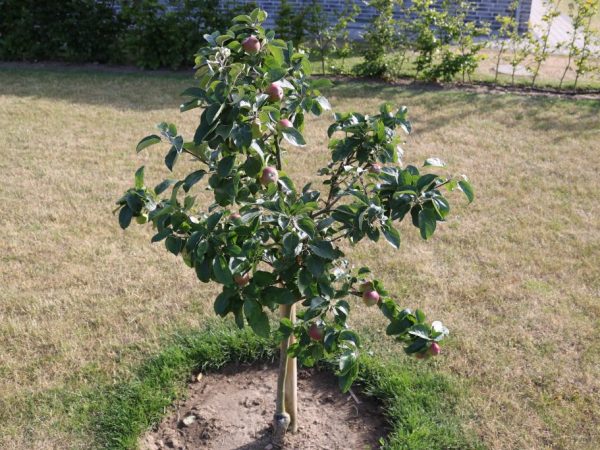
Varieties of dwarf apple trees for the Moscow region
general characteristics
Dwarf varieties have several important qualities:
- compact size - the height of the tree is about 3 m, in semi-dwarf ones - 3.5-4 m, so they can be planted in a small area;
- the shape of the crown is columnar or branched, with a circumference of about 30-40 or 60-70 cm, respectively;
- due to low growth, the harvesting procedure is facilitated;
- the plants produce a stable annual yield except for the usual varieties.
The only drawback is their short lifespan, so they need to be replaced more often than regular varieties.
Summer
This group includes early-maturing hybrid forms, which are harvested at the end of summer. After reading their description, you can choose a variety for your area.
Melba
In the third year of cultivation, the trees begin to give the first apples. Fruit picking is carried out at the end of July. The plant is prolific - at a mature age it gives about 40 kg of fruits.
Ball apples, slightly elongated, weighing 0.2 kg. Lime-colored peel with light yellow longitudinal stripes. At the end of ripening, a reddish blush appears on the fruit. The pulp is very sweet, aromatic, white with a caramel flavor.
The shelf life of the crop in a cool, well-ventilated area is 3-4 months.
The best pollinating varieties are Suislepskoe and Borovinka.
Candy
Gives tasty, small apples - their weight is 120-130 g.
Fruits are traditionally round, with a glossy, light green skin. Inside, they are dense, juicy with a pronounced apple aroma. Harvesting begins in early August.
The president
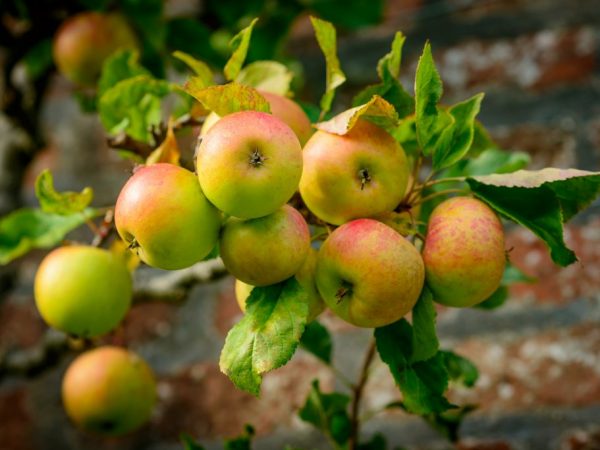
The variety will delight you with its yield
A dwarf apple tree, its maximum height is 2-2.5 m, the circumference is 2 m. Winter hardiness is high - it can withstand temperatures down to -30 °.
Large-fruited variety (weight 150-250 g). The apples are round, yellow in color with a blush on the side and a sweet-sour taste.
A young plant can be removed - 5-7 kg of fruit, adult trees yield up to 20 kg.
The disadvantage is that the fruits cannot be stored for a long time, they quickly deteriorate (1.5 months after removal).
Autumn
This group consists of varieties of dwarf apple trees for the Moscow region, the ripening period of which varies from early September to late October.
Gin
Dwarf hybrid form - in adulthood it reaches 2 m in height.
Apples are bright fiery color, average weight - 0.2 kg.Harvesting takes place in September.
The first fruits are tied two years after planting. Each year the tree increases the amount of harvest. Up to 15 kg can be removed from a five-year-old tree.
Zhigulevskoe
The tree forms the first fruit ovaries in the 3-4th year of cultivation. Harvesting takes place in the last decade of September.
The variety is large-fruited (weight 300 to 350 g). The apples are bright red, very juicy, sweet with a slight sourness.
This is one of the most resistant to diseases and parasites varieties of the autumn ripening period.
The disadvantage is poor frost resistance, so trees need good shelter for the winter.
Strafling
Variety Streyfling (or Autumn Striped) bears fruit with small fruits (their weight is 150-200 g). The apples are round or oval, green with vertical light yellow stripes. They taste sweet, with a slight sourness.
The tree has a shallow root system, so its resistance to winter cold is very weak. To avoid freezing of the roots, the near-stem zone is mulched with a thick layer of horse or cow manure, the trunk is covered with roofing material or spunbond.
Harvesting takes place in September.
Glory to the Winners
This variety of apple trees, growing in the Moscow region, ripens in early September.
Small apples - weigh 120-180 g. Light green or yellow, with a reddish blush. They taste sweet.
Winter
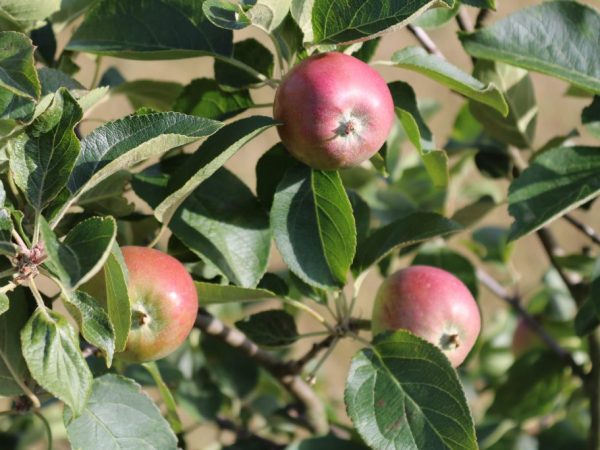
Winter varieties can be harvested in late autumn
These semi-dwarf varieties are suitable for the Moscow region, they ripen in late autumn and have a long shelf life.
Grushovka
One of the oldest varieties with high immunity from diseases and parasites. The tree enters the fruiting phase in the 5th or 6th year after planting. Despite low yields, it bears fruit every year.
The apples are small - they weigh about 100 g. They taste sweet, with a slight sourness. The aroma is pronounced.
Bogatyr
The first fruits appear on the tree 5-6 years after the seedling is planted. Differs in intensive growth, therefore, it needs pruning every year. Correct cutting of shoots increases the amount of yield - every year a young growth is trimmed by 1/3 of the length.
Low-growing apple trees are highly frost-resistant, they are also resistant to diseases and are practically not affected by pests.
Fruits are small - their weight is up to 80 g, rounded, slightly compressed in the area of the stalk. The color is yellowish-red. The variety is valued for its long shelf life - about 9 months.
Moscow necklace
A tree of short stature - 2.5-3 m, does not differ in strong growth, so pruning is not needed. The first harvest gives in the third year of life. The variety is resistant to scab, successfully tolerates severe winters.
Fruits are harvested in mid or late October. The average weight of the fruit is 150 g. The skin is burgundy, the pulp is pink, sweet, juicy. The shelf life is long - up to six months.
Arbat
A dwarf columnar variety with high yield rates - up to 30 kg of apples can be removed from one adult tree.
Fruits are small in size, weighing 100-120 g. The shape is round, slightly flattened. Scarlet skin with yellow tint elements. The pulp is creamy, juicy and very sweet.
Bolero
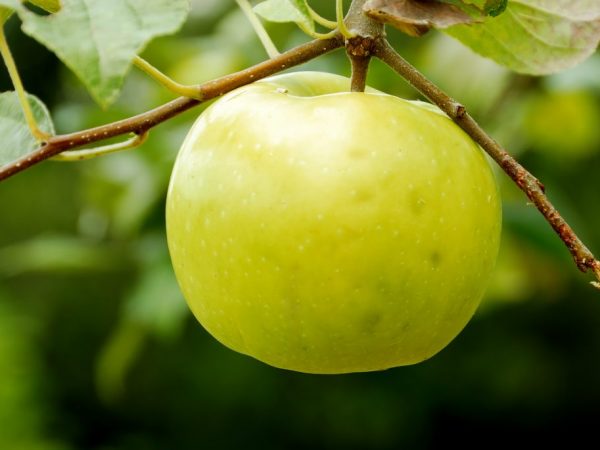
Fruits can be kept fresh for up to six months
The undersized hybrid bears large green fruits, their weight is about 200 g. The crop is very tasty, juicy and sweet, harvested in the last decade of September or early October.
It is appreciated for its excellent presentation and good keeping quality - up to 6 months.
Apple trees are self-fertile, therefore they do not need the neighborhood of pollinating varieties.
Growing features
Sapling selection
Not all gardeners manage to get a low-growing variety on a dwarf or semi-dwarf rootstock, so it is easier to purchase a ready-made seedling in a gardening nursery.
When choosing planting material, the roots should be carefully examined - they must be of the same color, at least 40 cm long.
The optimal length of the central conductor is 70 cm, there should be no branches on it, and the bark should be smooth without signs of disease, injury or mold.
For planting, it is better to choose seedlings aged 1-2 years, preferably with closed roots.
Site preparation and timing
The apple tree is a sun-loving crop, so it should be planted in a sunny place where there are no drafts. The soil is loamy, slightly acidic, loose and fertile.
Dwarf varieties can be planted in spring or fall. The advantage of spring planting is that the seedlings have a lot of time to adapt, which means that the risk of freezing in winter is minimized.
The site for planting is harvested in the fall - the soil is sprinkled with last year's manure (1 bucket), wood ash (1 kg), superphosphate (80 g) and potassium salt (50 g). The proportions are calculated for a plot of 1 sq. m. After fertilization, the soil is dug up and leveled.
With the arrival of spring, as soon as the snow thaws and the positive outside temperature stabilizes, you can start planting.
Disembarkation technique
Considering that dwarf varieties do not take up much space on the site, planting pits are pulled out at a distance of 50 cm from each other, observing the distance between the rows - 90-100 cm.

Dwarf trees do not take up much space
They are spilled with warm, settled water, half covered with garden soil, the roots are lowered and straightened. A wooden or metal stake is driven in next to it for support.
When deepening the roots, it is important that the root collar is slightly above the soil surface. The roots are covered with earth, trampled, the trunk is tied to a peg and abundantly moistened - three buckets of water are poured under one plant.
To prevent drying out of the soil, the near-trunk zone is mulched with manure, peat or garden soil.
Basic care
To increase immunity, full-fledged growth and fruiting, dwarf varieties require regular moisture, top dressing, pruning and loosening of the soil.
Watering
Seedlings are watered several times per season:
- in early spring - before the start of sap flow;
- 2 weeks before flowering;
- as soon as the apple tree fades;
- at the stage of pouring fruits;
- in the fall - after the leaves have fallen.
Depending on the age, a different amount of water is used - 2-3 buckets are poured under young trees, 8-9 buckets are poured under adults, fruiting apple trees.
Loosening and mulching
After watering, the soil is loosened to avoid the formation of an earthen crust on the surface. Useful vegetation helps to increase soil aeration - green peas, vetch, mustard are sown in the garden.
To prevent the soil from drying out and the growth of weeds, the near-stem zone of the seedlings is mulched with nutrients - horse, cow manure or peat.
Top dressing
Dwarf apple trees growing in the Moscow region need to be fed more often than ordinary varieties - every 14 days. Such a need for nutrients is due to abundant fruiting and the absence of a massive root system.
Starting from the third year of life, trees are fertilized with complex compositions for fruit plantations - 40 g of substance per bucket of water. Additionally fertilize with mullein solution (1 liter of substance per bucket of water). The resulting solution is diluted in 10 liters of water. Bring in twice - in early spring or in the middle of autumn.
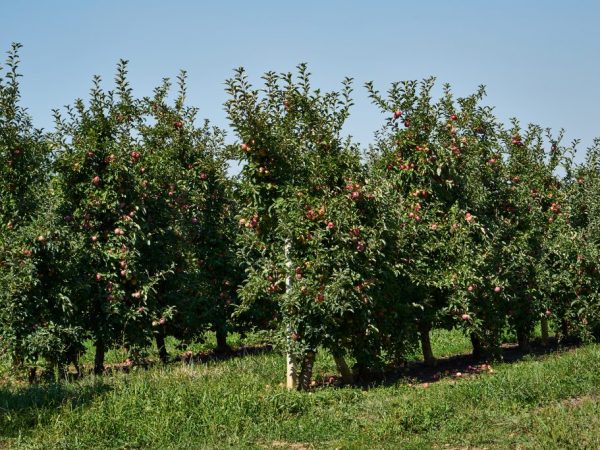
Apple trees need to be fed every two weeks.
In the summer, apple trees can be fed with complex mineral fertilizers: 1 tbsp. l. superphosphate and 2 tbsp. l. potassium is diluted in 10 liters of water. The same top dressing is applied in late autumn, after the foliage has fallen.
Preparing for the cold
Dwarf trees with shallow roots need good shelter. First, the trunk is treated with slaked lime, then sprinkled with a thick layer of mulch from peat, humus or garden soil, spruce branches are laid on top.
After the snow falls, the spruce branches are removed, and the trunk is sprinkled with a snowdrift.
Pruning
This procedure helps to form the correct crown shape of the tree and increase its yield. The procedure is carried out in early spring - at the end of March or at the beginning of April.
For dwarf columnar forms, only a sanitary haircut is carried out to remove organs damaged by frost, winds and diseases.
Low-growing varieties with a spreading crown are trimmed immediately after planting - the central stem is shortened by 20 cm, the next year it is pruned again, and the lateral branches are also trimmed by 15 cm.
Of the skeletal branches, 3-4 of the strongest are left in the first row. In the third year, a second row of 2-3 shoots is formed. All shoots growing inside the crown are cut into a ring.
Prevention of diseases and pests
During cultivation, a dwarf apple tree can be affected by powdery mildew, gray mold, cytosporosis, mosaic and rust. To destroy the pathogens of these sores, fungicides are used (copper sulfate, Bordeaux mixture). Crown processing is carried out in early spring and late autumn.
For parasites (aphids, moths, caterpillars) use insecticides - Actellik, Fundazol or Aktaru. A double treatment is carried out in spring and autumn - two weeks after the planned treatment for diseases.
As a preventive measure, you should avoid thickening the garden, remove weeds from the site in time, dig up the soil on the site annually and conduct regular inspections for the presence of diseases and pests.
Conclusion
For the Moscow region, varieties obtained by grafting an ordinary variety onto a dwarf or semi-dwarf rootstock are best suited. There are many such varieties, each of them has its own characteristics.
With good care, proper planting and proper attention, you can easily and successfully grow any apple tree. And she will give you a good and high-quality harvest in 2-3 years after planting.

